The Differential Role of Executive Functions in the Cognitive Control of Language Switching
Abstract
1. Introduction
2. Materials and Methods
2.1. Participants
2.2. Procedure
2.2.1. Verbal Fluency Measure
2.2.2. Picture-Naming Task
2.2.3. Simon Task
2.2.4. Running Memory Span Task
2.2.5. Task-Switching Numbers Task
2.3. Data Analyses
3. Results
3.1. Executive Functions Differentially Predict Switch Costs
3.1.1. Inhibitory Control
3.1.2. Working Memory
3.1.3. Task-Switching
4. Discussion
Integrating Models of General Cognitive Control and Multilingual Language Control
5. Conclusions
Author Contributions
Funding
Conflicts of Interest
Appendix A
| Final Best-Fitting Model | IC-Only Covariate Model | WM-Only Covariate Model | TS-Only Covariate Model | No Covariate Model | |||||||||||
|---|---|---|---|---|---|---|---|---|---|---|---|---|---|---|---|
| Predictor | Coefficient | SE | Coefficient | SE | Coefficient | SE | Coefficient | SE | Coefficient | SE | |||||
| Fixed (non-varying) effects | |||||||||||||||
| Intercept | 6.684 | * | 0.024 | 6.684 | * | 0.024 | 6.691 | * | 0.024 | 6.691 | * | 0.024 | 6.702 | * | 0.024 |
| L2 | 0.252 | * | 0.016 | 0.254 | * | 0.016 | 0.249 | * | 0.016 | 0.247 | * | 0.016 | 0.236 | * | 0.016 |
| L3 | 0.232 | * | 0.022 | 0.234 | * | 0.022 | 0.225 | * | 0.022 | 0.226 | * | 0.022 | 0.217 | * | 0.022 |
| Switch-from-higher | 0.183 | * | 0.009 | 0.183 | * | 0.009 | 0.183 | * | 0.009 | 0.184 | * | 0.009 | 0.183 | * | 0.009 |
| Switch-from-lower | 0.257 | * | 0.01 | 0.258 | * | 0.01 | 0.254 | * | 0.01 | 0.255 | * | 0.01 | 0.252 | * | 0.01 |
| IC | 0.052 | * | 0.024 | 0.043 | + | 0.023 | - | - | - | - | - | - | |||
| WM | −0.028 | 0.023 | - | - | −0.014 | 0.022 | - | - | - | - | |||||
| TS | −0.011 | 0.02 | - | - | - | - | −0.002 | 0.02 | - | - | |||||
| L2 × Switch-from-higher | 0.007 | 0.013 | 0.006 | 0.013 | 0.007 | 0.013 | 0.008 | 0.013 | 0.016 | 0.013 | |||||
| L3 × Switch-from-higher | −0.082 | * | 0.013 | −0.082 | * | 0.013 | −0.083 | * | 0.013 | −0.083 | * | 0.013 | −0.078 | * | 0.013 |
| L2 × Switch-from-lower | −0.101 | * | 0.014 | −0.103 | * | 0.014 | −0.101 | * | 0.013 | −0.1 | * | 0.013 | −0.093 | * | 0.013 |
| L3 × Switch-from-lower | −0.156 | * | 0.014 | −0.156 | * | 0.014 | −0.153 | * | 0.014 | −0.153 | * | 0.014 | −0.148 | * | 0.014 |
| L2 × IC | −0.024 | * | 0.007 | −0.033 | * | 0.007 | - | - | - | - | - | - | |||
| L3 × IC | −0.051 | * | 0.007 | −0.045 | * | 0.006 | - | - | - | - | - | - | |||
| L2 × WM | −0.014 | * | 0.006 | - | - | −0.015 | * | 0.006 | - | - | - | - | |||
| L3 × WM | 0.026 | * | 0.006 | - | - | 0.015 | * | 0.006 | - | - | - | - | |||
| L2 × TS | −0.035 | * | 0.006 | - | - | - | - | −0.036 | * | 0.006 | - | - | |||
| L3 × TS | −0.004 | 0.006 | - | - | - | - | −0.013 | * | 0.006 | - | - | ||||
| Switch-from-higher × IC | 0.001 | 0.01 | 0.004 | 0.01 | - | - | - | - | - | - | |||||
| Switch-from-lower × IC | −0.024 | * | 0.011 | −0.019 | + | 0.011 | - | - | - | - | - | - | |||
| Switch-from-higher × WM | 0.011 | 0.009 | - | - | 0.011 | 0.009 | - | - | - | - | |||||
| Switch-from-lower × WM | 0.028 | * | 0.011 | - | - | 0.024 | * | 0.01 | - | - | - | - | |||
| Switch-from-higher × TS | −0.002 | 0.008 | - | - | - | - | −0.003 | 0.008 | - | - | |||||
| Switch-from-lower × TS | −0.013 | 0.01 | - | - | - | - | −0.019 | * | 0.009 | - | - | ||||
| L2 × Switch-from-higher × IC | 0.002 | 0.015 | 0.009 | 0.014 | - | - | - | - | - | - | |||||
| L3 × Switch-from-higher × IC | −0.002 | 0.015 | −0.0012 | 0.014 | - | - | - | - | - | - | |||||
| L2 × Switch-from-lower × IC | 0.01 | 0.015 | 0.009 | 0.015 | - | - | - | - | - | - | |||||
| L3 × Switch-from-lower × IC | 0.023 | 0.015 | 0.02 | 0.015 | - | - | - | - | - | - | |||||
| L2 × Switch-from-higher × WM | 0.018 | 0.014 | - | - | 0.016 | 0.013 | - | - | - | - | |||||
| L3 × Switch-from-higher × WM | 0.003 | 0.014 | - | - | 0.003 | 0.013 | - | - | - | - | |||||
| L2 × Switch-from-lower × WM | −0.015 | 0.014 | - | - | −0.016 | 0.014 | - | - | - | - | |||||
| L3 × Switch-from-lower × WM | −0.013 | 0.014 | - | - | −0.009 | 0.014 | - | - | - | - | |||||
| L2 × Switch-from-higher × TS | 0.018 | 0.012 | - | - | - | - | 0.016 | 0.012 | - | - | |||||
| L3 × Switch-from-higher × TS | 0 | 0.012 | - | - | - | - | −0.0008 | 0.012 | - | - | |||||
| L2 × Switch-from-lower × TS | 0.025 | + | 0.013 | - | - | - | - | 0.028 | * | 0.013 | - | - | |||
| L3 × Switch-from-lower × TS | 0.01 | 0.013 | - | - | - | - | 0.014 | 0.013 | - | - | |||||
| Random (varying intercept) components | |||||||||||||||
| Subjects | 0.018 | 0.017 | 0.02 | 0.018 | 0.017 | ||||||||||
| Items | 0.005 | 0.005 | 0.01 | 0.005 | 0.005 | ||||||||||
| Residual | 0.265 | 0.071 | 0.07 | 0.071 | 0.071 | ||||||||||
| Fit statistics | |||||||||||||||
| ML deviance (# of parameters) | 4182 (40) | 4301 (22) | 4455 (22) | 4323 (22) | 4377 (12) | ||||||||||
| AIC; BIC | 4530; 4840 | 4474; 4641 | 4497; 4664 | 4497; 4664 | 4465; 4560 | ||||||||||
References
- Abutalebi, Jubin, and David Green. 2008. Control mechanisms in bilingual language production: Neural evidence from language switching studies. Language and Cognitive Processes 23: 557–82. [Google Scholar] [CrossRef]
- Abutalebi, Jubin, Stefano Cappa, and Daniela Perani. 2001. The bilingual brain as revealed by functional neuroimaging. Bilingualism: Language and Cognition 4: 179–90. [Google Scholar] [CrossRef]
- Anderson, Michael. 2003. Rethinking interference theory: Executive control and the mechanisms of forgetting. Journal of Memory and Language 49: 415–45. [Google Scholar] [CrossRef]
- Andrews, Sally. 1997. The effect of orthographic similarity on lexical retrieval: Resolving neighborhood conflicts. Psychonomic Bulletin and Review 4: 439–61. [Google Scholar] [CrossRef]
- Andrews, Edna. 2014. Neuroscience and Multilingualism. Cambridge: Cambridge University Press. [Google Scholar]
- Antoniou, Mark. 2019. The advantages of bilingualism debate. Annual Review of Linguistics 5: 395–415. [Google Scholar] [CrossRef]
- Austin, John. 1975. How to Do Things with Words. Oxford: Oxford University Press. [Google Scholar]
- Bates, Douglas, and Martin Maechler. 2010. lme4: Linear Mixed-Effects Models Using S4 Classes. R Package Version 0.999375-36. Available online: http://CRAN.R-project.org/package=lme4 (accessed on 20 December 2019).
- Bialystok, Ellen. 2017. The bilingual adaptation: How minds accommodate experience. Psychological Bulletin 143: 233–62. [Google Scholar] [CrossRef] [PubMed]
- Bialystok, Ellen, and Fergus Craik. 2010. Cognitive and linguistic processing in the bilingual mind. Current Directions in Psychological Science 19: 19–23. [Google Scholar] [CrossRef]
- Bialystok, Ellen, Fergus Craik, Raymound Klein, and Mythili Viswanathan. 2004. Bilingualism, aging, and cognitive control: Evidence from the Simon task. Psychology and Aging 19: 290–303. [Google Scholar] [CrossRef]
- Bialystok, Ellen, Fergus Craik, Cheryl Grady, Wilkin Chau, Ryouhei Ishii, Atsuko Gunji, and Christo Pantev. 2005. Effect of bilingualism on cognitive control in the Simon task: Evidence from MEG. NeuroImage 24: 40–49. [Google Scholar] [CrossRef]
- Branzi, Francesca, Marco Calabria, Maria Boscarino, and Albert Costa. 2016. On the overlap between bilingual language control and domain-general executive control. Acta Psychologica 166: 21–30. [Google Scholar] [CrossRef]
- Braver, Todd, Jeremy Reynolds, and David Donaldson. 2003. Neural mechanisms of transient and sustained cognitive control during task switching. Neuron 39: 713–26. [Google Scholar] [CrossRef]
- Bunting, Michael, Nelson Cowan, and J. Scott Saults. 2006. How does running memory span work? The Quarterly Journal of Experimental Psychology 59: 1691–700. [Google Scholar] [CrossRef] [PubMed]
- Calabria, Marco, Cristinai Baus, and Albert Costa. 2019. Cross-talk between language and executive control. In The Handbook of the Neuroscience of Multilingualism. Edited by John W. Schwieter. Maldon: Wiley, pp. 447–66. [Google Scholar]
- Christoffels, Ingrid, Annette De Groot, and Lourens Waldorp. 2003. Basic skills in a complex task: A graphical model relating memory and lexical retrieval to simultaneous interpreting. Bilingualism: Language and Cognition 6: 201–11. [Google Scholar] [CrossRef]
- Colzato, Lorenza, M. Teresa Bajo, Wery van den Wildenberg, Daniela Paolieri, Sander Nieuwenhuis, Wido La Heij, and Bernhard Hommel. 2008. How does bilingualism improve executive control? A comparison of active and reactive inhibition mechanisms. Journal of Experimental Psychology: Learning, Memory and Cognition 34: 302–12. [Google Scholar] [CrossRef]
- Costa, Albert, and Mikel Santesteban. 2004. Lexical access in bilingual speech production: Evidence from language switching in highly proficient bilinguals and L2 learners. Journal of Memory and Language 50: 491–511. [Google Scholar] [CrossRef]
- Costa, Albert, Michelle Miozzo, and Alfonso Caramazza. 1999. Lexical selection in bilinguals: Do words in the bilinguals’ two lexicons compete for selection? Journal of Memory and Language 41: 365–97. [Google Scholar] [CrossRef]
- Costa, Albert, Mikel Santesteban, and Iva Ivanova. 2006. How do highly proficient bilinguals control their lexicalization process? Inhibitory and language-specific selection mechanisms are both functional. Journal of Experimental Psychology: Learning, Memory, and Cognition 32: 1057–74. [Google Scholar] [CrossRef]
- De Baene, Wouter, Simone Kühn, and Marcel Brass. 2012. Challenging a decade of brain research on task switching: Brain activation in the task-switching paradigm reflects adaptation rather than reconfiguration of task sets. Human Brain Mapping 33: 639–51. [Google Scholar] [CrossRef]
- De Bot, Kees. 2008. Review article: The imaging of what in the multilingual mind? Second Language Research 24: 111–33. [Google Scholar] [CrossRef]
- De Groot, Annette, and Ingrid Christoffels. 2006. Language control in bilinguals: Monolingual tasks and simultaneous interpreting. Bilingualism: Language and Cognition 9: 189–201. [Google Scholar] [CrossRef]
- Declerck, Mathieu, Jonathan Grainger, Iring Koch, and Andrea Philipp. 2017. Is language control just a form of executive control? Evidence for overlapping processes in language switching and task switching. Journal of Memory and Language 95: 138–45. [Google Scholar] [CrossRef]
- Dijkstra, Ton, and Walter Van Heuven. 2002. The architecture of the bilingual word recognition system: From identification to decision. Bilingualism: Language and Cognition 5: 175–97. [Google Scholar] [CrossRef]
- Engle, Randall. 2002. Working memory capacity as executive attention. Current Directions in Psychological Science 11: 19–23. [Google Scholar] [CrossRef]
- Festman, Julia, and Thomas Münte. 2012. Cognitive control in Russian–German bilinguals. Frontiers in Psychology 3: 115. [Google Scholar] [CrossRef]
- Festman, Julia, Antoni Rodríguez-Fornells, and Thomas Münte. 2010. Individual differences in control of language interference in late bilinguals are mainly related to general executive abilities. Behavioral and Brain Functions 6: 5. [Google Scholar] [CrossRef]
- Friedman, Naomi, and Akira Miyake. 2004. The relations among inhibition and interference control functions: A latent-variable analysis. Journal of Experimental Psychology: General 133: 101–35. [Google Scholar] [CrossRef]
- Garbin, G., Albert Costa, Ana Sanjuan, Cristina Forn, Aina Rodriguez-Pujadas, Noelia Ventura, Vicente Belloch, Mireia Hernandez, and Cesar Ávila. 2011. Neural bases of language switching in high and early proficient bilinguals. Brain & Language 119: 129–35. [Google Scholar]
- Gelman, Andrew, and Jennifer Hill. 2007. Data Analysis Using Regression and Multilevel/Hierarchical Models. New York: Cambridge University Press. [Google Scholar]
- Green, David. 1998. Mental control of the bilingual lexico-semantic system. Bilingualism: Language and Cognition 1: 67–81. [Google Scholar] [CrossRef]
- Grundy, John, and Kalinka Timmer. 2017. Bilingualism and working memory capacity: A comprehensive meta-analysis. Second Language Research 33: 325–40. [Google Scholar] [CrossRef]
- Guo, Taomei, Hongyan Liu, Maya Misra, and Judith Kroll. 2011. Local and global inhibition in bilingual word production: fMRI evidence from Chinese-English bilinguals. NeuroImage 56: 2300–9. [Google Scholar] [CrossRef]
- Hermans, Daan. 2000. Word Production in a Foreign Language. Doctoral dissertation, University of Nijmegen, Nijmegen, The Netherlands. [Google Scholar]
- Hermans, Daan, Theo Bongaerts, Kees De Bot, and Robert Schreuder. 1998. Producing words in a foreign language: Can speakers prevent interference from their first language? Bilingualism: Language and Cognition 1: 213–29. [Google Scholar] [CrossRef]
- Hernandez, Arturo E. 2009. Language switching in the bilingual brain: What’s next? Brain & Language 109: 133–40. [Google Scholar]
- Hernandez, Arturo, Antigona Martinez, and Kathryn Kohnert. 2000. In search of the language switch: An fMRI study of picture naming in Spanish-English bilinguals. Brain and Language 73: 421–31. [Google Scholar] [CrossRef] [PubMed]
- Hernandez, Arturo, Mirella Dapretto, John Mazziotta, and Susan Bookheimer. 2001. Language switching and language representation in Spanish-English Bilinguals: An fMRI study. Neuroimage 14: 510–20. [Google Scholar] [CrossRef] [PubMed]
- Hilchey, Matthew, and Raymound Klein. 2011. Are there bilingual advantages on nonlinguistic interference tasks? Implications for the plasticity of executive control processes. Psychonomic Bulletin and Review 18: 625–58. [Google Scholar] [CrossRef] [PubMed]
- Jakobson, Roman. 1960. Linguistics and poetics. In Style in language. Edited by Thomas Sebeok. Cambridge: MIT Press, pp. 350–77. [Google Scholar]
- Kaushanskaya, Margarita, and Kimberly Crespo. 2019. Does Exposure to Code-Switching Influence Language Performance in Bilingual Children? Child Development 90: 708–18. [Google Scholar] [CrossRef] [PubMed]
- Koch, Iring, Miriam Gade, Stefanie Schuch, and Andrea Philipp. 2010. The role of inhibition in task switching: An overview. Psychonomic Bulletin and Review 17: 1–14. [Google Scholar] [CrossRef]
- Kornblum, Sylvan, Thierry Hasbroucq, and Allen Osman. 1990. Dimensional overlap: Cognitive basis for stimulus-response compatibility—A model and taxonomy. Psychological Review 97: 253–70. [Google Scholar] [CrossRef]
- Kroll, Judith, Erica Michael, Natasha Tokowicz, and Robert Dufour. 2002. The development of lexical fluency in a second language. Second Language Research 18: 137–71. [Google Scholar] [CrossRef]
- Kroll, Judith, Susan Bobb, and Zofia Wodniecka. 2006. Language selectivity is the exception, not the rule: Arguments against a fixed locus of language selection in bilingual speech. Bilingualism: Language and Cognition 9: 119–35. [Google Scholar] [CrossRef]
- Levelt, Willem. 1989. Speaking: From Intention to Articulation. Cambridge: MIT Press. [Google Scholar]
- Levinson, Stephen. 2017. Speech acts. In The Oxford Handbook of Pragmatics. Edited by Yan Huang. Oxford: Oxford University Press, pp. 199–216. [Google Scholar]
- Levinson, Stephen. 2018. Spatial cognition, empathy and language evolution. Studies in Pragmatics 20: 16–21. [Google Scholar]
- Levy, Benjamin, and Michael Anderson. 2002. Inhibitory processes and the control of memory retrieval. Trends in Cognitive Sciences 6: 299–305. [Google Scholar] [CrossRef]
- Levy, Benjamin, Nathan McVeigh, Alejandra Marful, and Michael Anderson. 2007. Inhibiting your native language: The role of retrieval-induced forgetting during second-language acquisition. Psychological Science 18: 29–34. [Google Scholar] [CrossRef] [PubMed]
- Linck, Jared, John W. Schwieter, and Gretchen Sunderman. 2012. Inhibitory control predicts language switching performance in trilingual speech production. Bilingualism: Language and Cognition 15: 651–62. [Google Scholar] [CrossRef]
- Liu, Cong, Chin-Lung Yang, Lu Jiao, John W. Schwieter, Xun Sun, and Ruiming Wang. 2019. Training in language switching facilitates bilinguals’ monitoring and inhibitory control. Frontiers in Psychology 10: 1–13. [Google Scholar] [CrossRef] [PubMed]
- Lotman, Yuri. 1990. Universe of the Mind: A Semiotic Theory of Culture. London: I.B. Tauris. [Google Scholar]
- Mayr, Ulrich, and Steven Keele. 2000. Changing internal constraints on action: The role of backward inhibition. Journal of Experimental Psychology: General 129: 4–26. [Google Scholar] [CrossRef]
- Meuter, Renata, and Alan Allport. 1999. Bilingual language switching in naming: Asymmetrical costs of language selection. Journal of Memory and Language 40: 25–40. [Google Scholar] [CrossRef]
- Morales, Luis, Daniela Paolieri, and M. Teresa Bajo. 2011. Grammatical gender inhibition in bilinguals. Frontiers in Psychology 2: 284. [Google Scholar] [CrossRef]
- Price, Cathy J., David W. Green, and Roswitha Von Studnitz. 1999. A functional imaging study of translation and language switching. Brain 122: 2221–35. [Google Scholar] [CrossRef]
- Prior, Anat, and Tamar Gollan. 2011. Good language-switchers are good task-switchers: Evidence from Spanish–English and Mandarin–English bilinguals. Journal of the International Neuropsychological Society 17: 682–91. [Google Scholar] [CrossRef]
- Prior, Anat, and Tamar Gollan. 2013. The elusive link between language control and executive control: A case of limited transfer. Journal of Cognitive Psychology 25: 622–45. [Google Scholar] [CrossRef] [PubMed]
- R development core team. 2010. R: A Language and Environment for Statistical Computing. Vienna: R Foundation for Statistical Computing. Available online: http://www.R-project.org (accessed on 20 December 2019).
- Raudenbush, Stephen, and Anthony Bryk. 2002. Hierarchical Linear Models: Applications and Data Analysis Methods. Thousand Oaks: Sage. [Google Scholar]
- Runnqvist, Elin, and Albert Costa. 2012. Is retrieval-induced forgetting behind the bilingual disadvantage in word production? Bilingualism: Language and Cognition 15: 365–77. [Google Scholar] [CrossRef]
- Schwieter, John W. 2019. The Handbook of the Neuroscience of Multilingualism. Malden and Oxford: Wiley-Blackwell. [Google Scholar]
- Schwieter, John W., and Gretchen Sunderman. 2008. Language switching in bilingual speech production: In search of the language-specific selection mechanism. The Mental Lexicon 3: 214–38. [Google Scholar] [CrossRef]
- Schwieter, John W., and Gretchen Sunderman. 2009. Concept selection and developmental effects in bilingual speech production. Language Learning 59: 897–927. [Google Scholar] [CrossRef]
- Schwieter, John W., and Gretchen Sunderman. 2011. Inhibitory control processes and lexical access in trilingual speech production. Linguistic Approaches to Bilingualism 1: 391–412. [Google Scholar] [CrossRef]
- Searle, John. 1969. Speech Acts. Cambridge: Cambridge University Press. [Google Scholar]
- Segal, Dorit, Alena Stasenko, and Tamar Gollan. 2019. More evidence that a switch is not a switch: Binning bilinguals reveals dissociations between task and language switching. Journal of Experimental Psychology 148: 501–19. [Google Scholar] [CrossRef]
- Simon, J. Richard, and Alan Rudell. 1967. Auditory S-R compatibility: The effect of an irrelevant cue on information processing. Journal of Applied Psychology 51: 300–4. [Google Scholar] [CrossRef]
- Snodgrass, Joan, and Mary Vanderwart. 1980. A standardized set of 260 pictures: Norms for name agreement, image agreement, familiarity, and visual complexity. Journal of Experimental Psychology: Human Learning and Memory 6: 174–215. [Google Scholar] [CrossRef]
- Timmer, Kalinka, Marco Calabria, and Albert Costa. 2019. Non-linguistic effects of language switching training. Cognition 182: 14–24. [Google Scholar] [CrossRef]
- Vygotsky, Lev. 1962. Thought and Language. Cambridge: MIT Press. [Google Scholar]
- Wiseheart, Melody, Mythili Viswanathan, and Ellen Bialystok. 2016. Flexibility in task switching by monolinguals and bilinguals. Bilingualism: Language and Cognition 19: 141–46. [Google Scholar] [CrossRef]
| 1 | |
| 2 | Colzato et al. (2008) also examined both reactive and proactive inhibitory mechanisms, which are likely to support bilingual language processes in different contexts. |
| 3 | Relying on self-ratings of proficiency is less ideal than on data from standardized measures such as the Common European Framework of Reference for Languages (Andrews 2014; De Bot 2008; Schwieter 2019). When possible, future studies should use these types of measures to avoid this potential limitation. |
| 4 | Preliminary analyses indicated that the standard Simon effect scores (incongruent trial mean response times (RTs) minus congruent trial mean RTs) and task-switching switch cost scores (switch trial mean RTs minus non-switch trial mean RTs) were not normally distributed for this sample. Trial-level RTs were log-transformed prior to computing the condition means, resulting in more normally distributed scores. All mixed effects models were refit using standard Simon and task-switching scores (based on raw RTs), and the overall pattern of results remained the same. |
| 5 | The inclusion of all three EFs significantly improved the fit of the model over simpler models, based on chi-square tests of model likelihoods. See Appendix A for coefficients and model fit statistics. |
| 6 | Morales et al. (2011) found similar results extending to a word’s grammatical gender, suggesting that such inhibitory effects may span across levels within the bilingual language system. For a counterargument, see Runnqvist and Costa (2012), who found that repeated production of words in a non-dominant language enhanced lexical retrieval in the dominant language. |
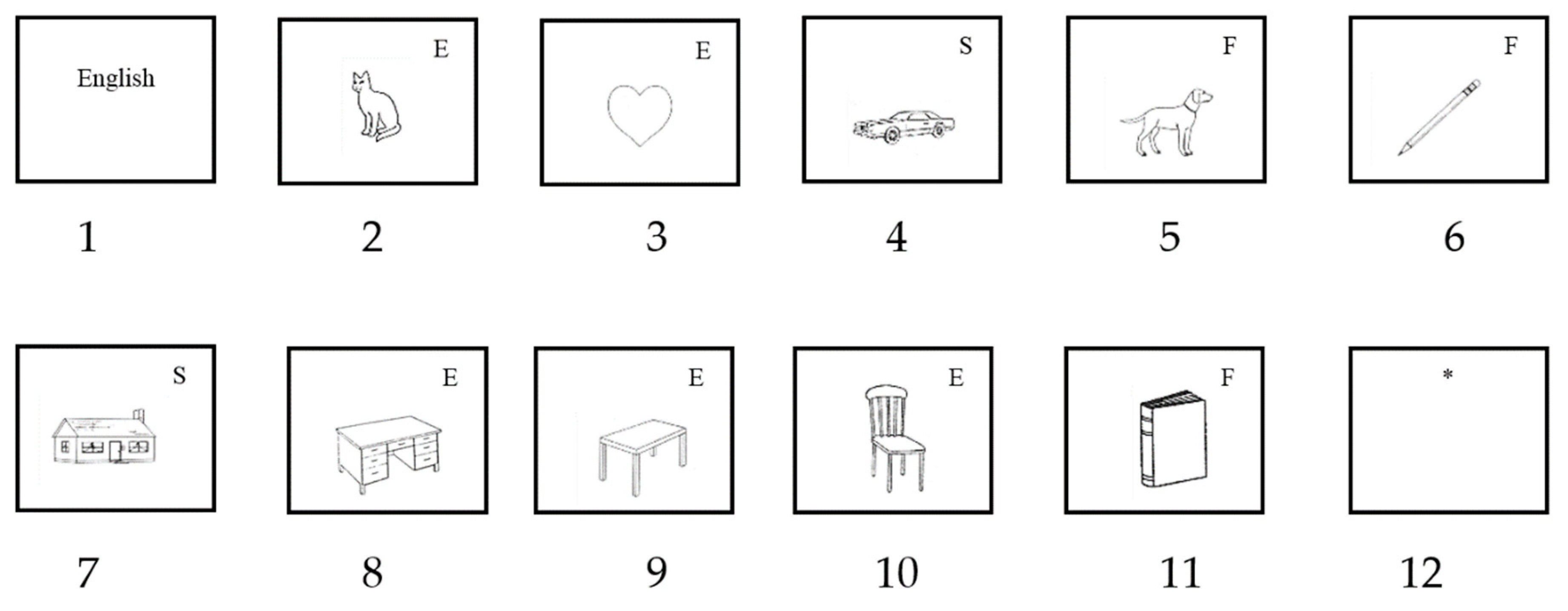
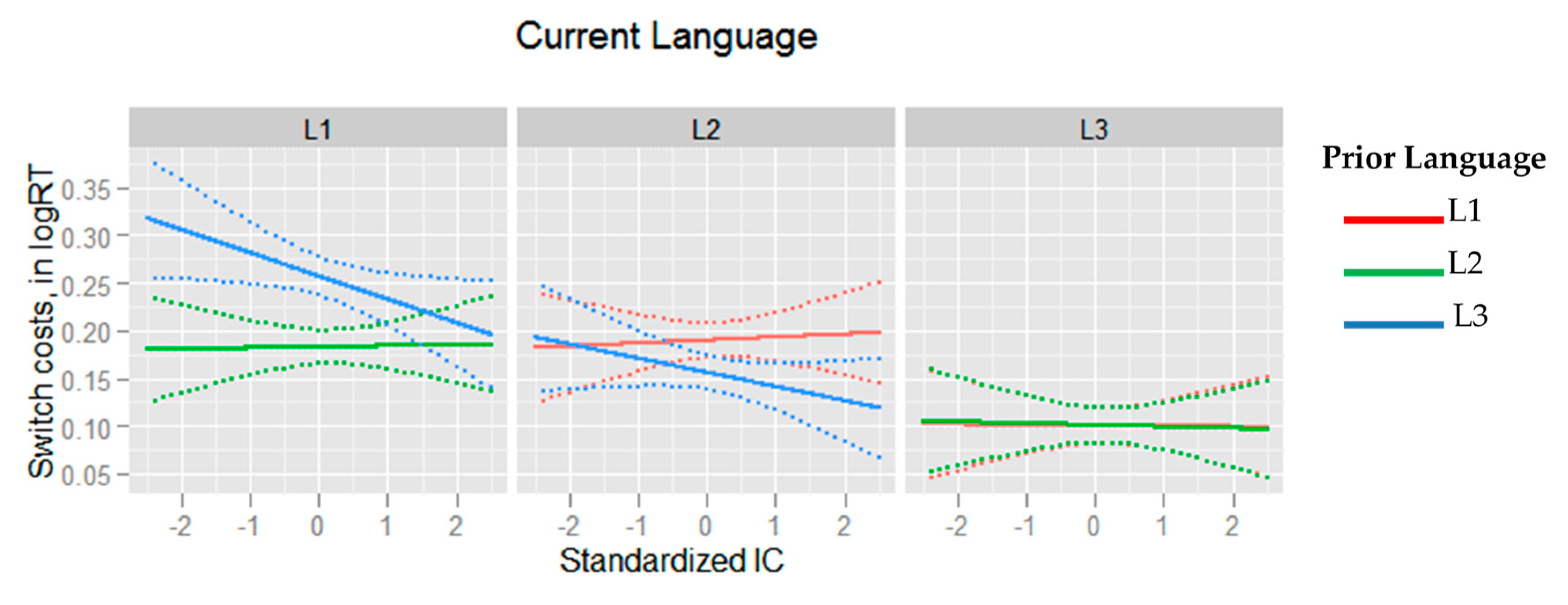
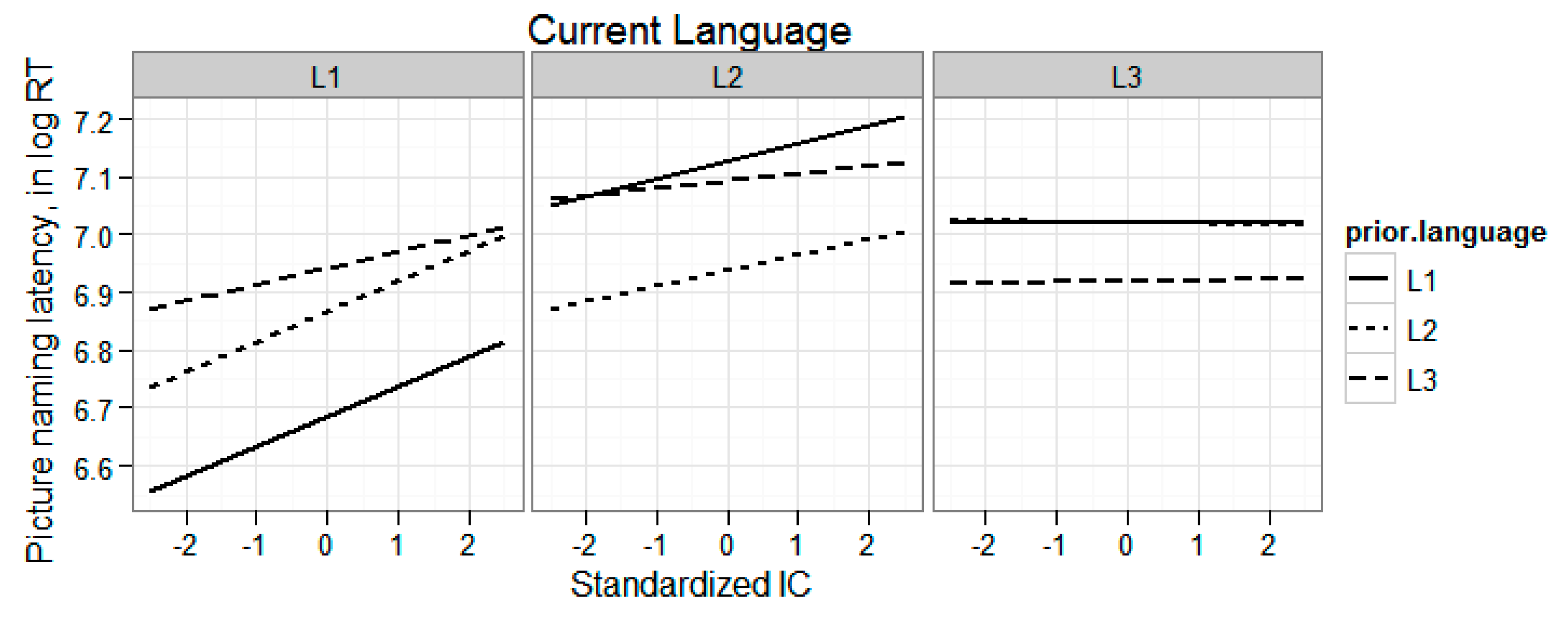
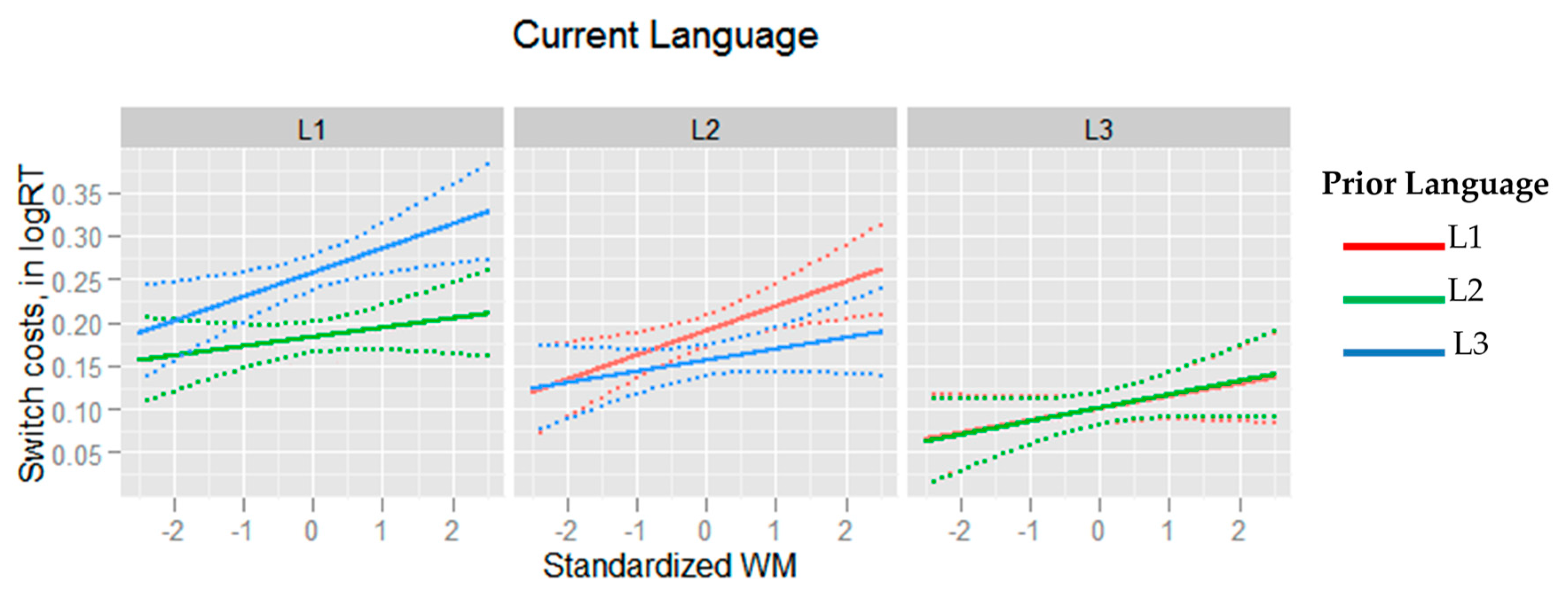
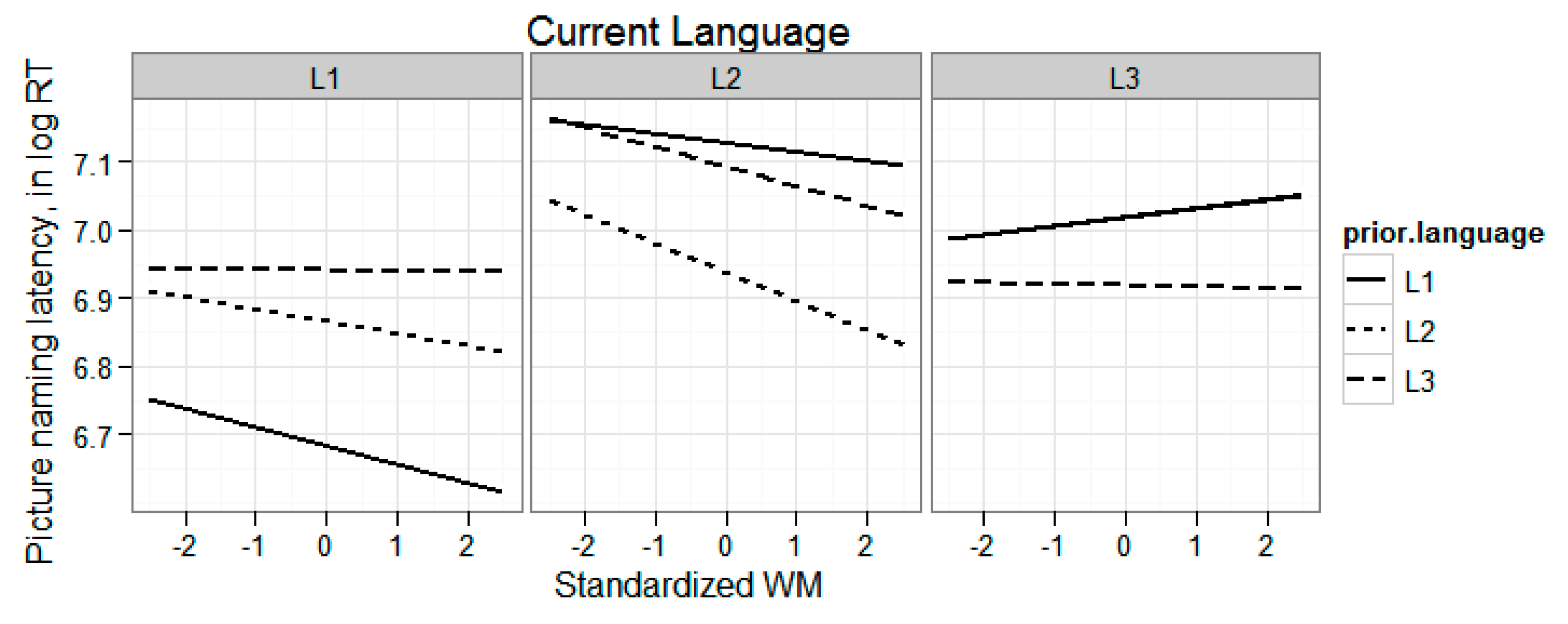
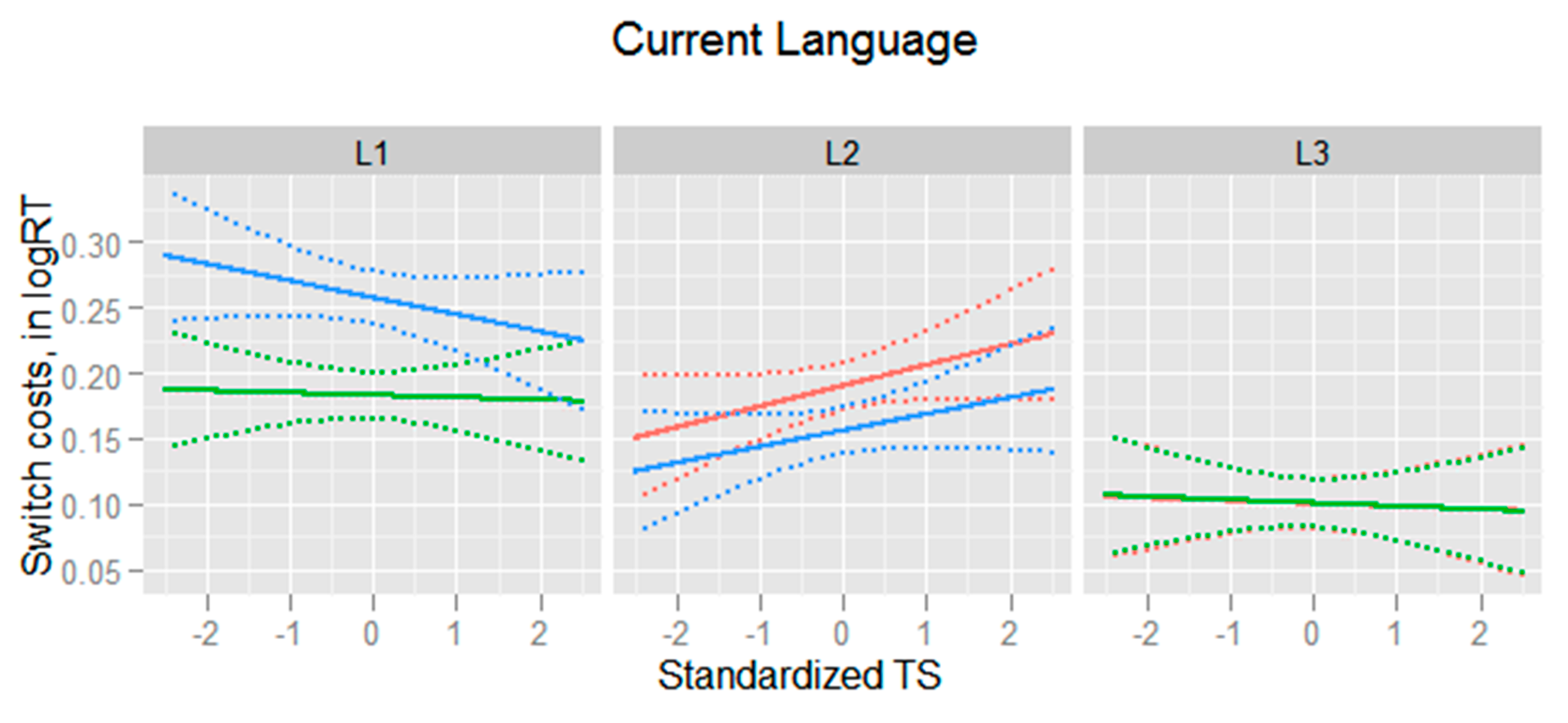
| L1 | L2 | L3 | ||||
|---|---|---|---|---|---|---|
| Age of Acquisition | 0.49 | (1.58) | 6.67 | (3.97) | 16.7 | (2.92) |
| Self-ratings of Ability | ||||||
| Reading | 9.88 | (0.33) | 7.66 | (1.89) | 5.86 | (1.90) |
| Writing | 9.76 | (0.52) | 6.78 | (1.88) | 5.28 | (2.15) |
| Speaking | 9.84 | (0.47) | 6.65 | (2.10) | 5.16 | (2.11) |
| Listening | 9.92 | (0.34) | 7.53 | (2.00) | 6.02 | (2.37) |
| Overall | 9.94 | (0.25) | 6.74 | (1.85) | 4.84 | (2.08) |
| Lexical robustness | 132.43 | (24.45) | 67.18 | (22.83) | 44.31 | (17.24) |
| % Daily use | 76.15 | (12.56) | 11.71 | (7.69) | 7.05 | (4.63) |
| Mean | SD | |
|---|---|---|
| Simon task | ||
| Central | 380 | (55) |
| Congruent | 365 | (65) |
| Incongruent | 393 | (58) |
| Simon effect | 28 | (22) |
| Running memory span task | 2.89 | (0.75) |
| Task-switching task | ||
| Pure | 505 | (63) |
| Non-switch | 1107 | (235) |
| Switch | 680 | (142) |
| Mix cost | 174 | (115) |
| Switch cost | 427 | (200) |
| Current Trial | ||||||
|---|---|---|---|---|---|---|
| Preceding Trial | L1 | L2 | L3 | |||
| Reaction times | ||||||
| L1 | 866 | (131) | 1284 | (212) | 1134 | (176) |
| L2 | 1048 | (184) | 1059 | (160) | 1200 | (205) |
| L3 | 1114 | (190) | 1243 | (196) | 1066 | (167) |
| Accuracy | ||||||
| L1 | 97.4 | (2.8) | 92.9 | (5.4) | 93.1 | (6.2) |
| L2 | 94.3 | (5.8) | 92.3 | (5.2) | 94.8 | (7.6) |
| L3 | 93.4 | (6.0) | 92.9 | (7.2) | 93.5 | (6.4) |
| Current Language of Naming | ||||||
|---|---|---|---|---|---|---|
| Parameter | L1 | L2 | L3 | |||
| IC (non-switch) | 0.052 * | (0.024) | 0.028 | (0.024) | 0.001 | (0.024) |
| IC × Switch-from-L1 | -- | -- | 0.003 | (0.011) | −0.001 | (0.011) |
| IC × Switch-from-L2 | 0.001 | (0.010) | -- | -- | −0.002 | (0.010) |
| IC × Switch-from-L3 | −0.024 * | (0.011) | −0.015 | (0.011) | -- | -- |
| WM (non-switch) | −0.028 | (0.023) | −0.042 | (0.023) | −0.002 | (0.023) |
| WM × Switch-from-L1 | -- | -- | 0.028 * | (0.010) | 0.014 | (0.010) |
| WM × Switch-from-L2 | 0.011 | (0.009) | -- | -- | 0.015 | (0.010) |
| WM × Switch-from-L3 | 0.028 * | (0.011) | 0.013 | (0.010) | -- | -- |
| TS (non-switch) | −0.011 | (0.020) | −0.046 * | (0.021) | −0.015 | (0.020) |
| TS × Switch-from-L1 | -- | -- | 0.016 | (0.009) | −0.002 | (0.009) |
| TS × Switch-from-L2 | −0.002 | (0.008) | -- | -- | −0.002 | (0.009) |
| TS × Switch-from-L3 | −0.013 | (0.010) | 0.012 | (0.009) | -- | -- |
© 2020 by the authors. Licensee MDPI, Basel, Switzerland. This article is an open access article distributed under the terms and conditions of the Creative Commons Attribution (CC BY) license (http://creativecommons.org/licenses/by/4.0/).
Share and Cite
Linck, J.A.; Schwieter, J.W.; Sunderman, G. The Differential Role of Executive Functions in the Cognitive Control of Language Switching. Languages 2020, 5, 19. https://doi.org/10.3390/languages5020019
Linck JA, Schwieter JW, Sunderman G. The Differential Role of Executive Functions in the Cognitive Control of Language Switching. Languages. 2020; 5(2):19. https://doi.org/10.3390/languages5020019
Chicago/Turabian StyleLinck, Jared A., John W. Schwieter, and Gretchen Sunderman. 2020. "The Differential Role of Executive Functions in the Cognitive Control of Language Switching" Languages 5, no. 2: 19. https://doi.org/10.3390/languages5020019
APA StyleLinck, J. A., Schwieter, J. W., & Sunderman, G. (2020). The Differential Role of Executive Functions in the Cognitive Control of Language Switching. Languages, 5(2), 19. https://doi.org/10.3390/languages5020019





